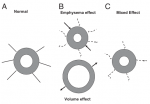Citation:
| chest_2013_diaz.pdf | 906 KB |

Date Published:
Mar 08Abstract:
ABSTRACT BACKGROUND: In CT scans of smokers with COPD, the subsegmental airway wall area percent (WA%) is greater and more strongly correlated with FEV1% predicted than WA% obtained in the segmental airways. Since emphysema is linked to loss of airway tethering and may limit airway expansion, increases in WA% may be related to emphysema and not solely due to remodeling. We aimed to first determine if the stronger association of subsegmental vs. segmental WA% with FEV1% predicted is mitigated by emphysema; and second, to assess the relationships between emphysema, WA%, and total bronchial area (TBA). METHODS: We analyzed CT segmental and subsegmental WA% (WA%=100*wall area/TBA) of six bronchial paths and corresponding lobar emphysema, lung function, and clinical data in 983 smokers with COPD. RESULTS: Compared to segmental, the subsegmental WA% had a greater effect on FEV1% predicted (-0.8 to -1.7% vs. -1.9 to -2.6% per 1-unit increase in WA%, respectively; P<0.05 for most bronchial paths). After adjusting for emphysema, the association between subsegmental WA% and FEV1% predicted was weakened in two bronchial paths. Increases in WA% between bronchial segments correlated directly with emphysema in all bronchial paths (P<0.05). In multivariate regression models, emphysema was directly related to subsegmental WA% in most bronchial paths and inversely related to subsegmental TBA in all bronchial paths. CONCLUSION: The greater effect of subsegmental WA% on airflow obstruction is mitigated by emphysema. Part of the emphysema effect might be due to loss of airway tethering leading to reduction in TBA and increase in WA%.